EARTH students achieve fruitful success with their Graduation Projects
Every year, the students in the last stage of their degree at our University work for months on a Graduation Project (GP) that focuses on their primary professional interests. This time of year, more than 100 students defend their research results in front of the faculty. It is the crowning moment of a four-year journey through EARTH and is the one that allows them to graduate with a degree in Agricultural Sciences.
We share the stories of two EARTH students who stand out for their determination and effort to achieve excellence with their Graduation Projects.
A solution for controlling Black Sigatoka
 Black Sigatoka, also known as black leaf streak, is the dominant banana plant disease worldwide. The devastating leaf-spot disease is caused by the fungus Pseudocercospora fijiensis and can induce yield loss of 35% to 100%, depending on the clone.
Black Sigatoka, also known as black leaf streak, is the dominant banana plant disease worldwide. The devastating leaf-spot disease is caused by the fungus Pseudocercospora fijiensis and can induce yield loss of 35% to 100%, depending on the clone.
After Alejandra Bolaños (‘22, Guatemala) did her internship in 2021 with AMVAC, a leading company in agricultural supplies in Central America and the Caribbean, she knew she wanted to focus her GP on precision agriculture and the use of drones to control Black Sigatoka. She was also inspired by assisting Emir Gian Majil (‘21, Belize) with his GP on the topic that same year.
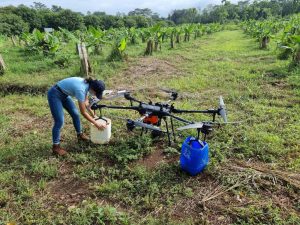 One of the most common products to treat the disease is Mancozeb, an agricultural fungicide with multi-site action, used for its high efficiency and ability to prevent resistance development by the fungus. However, it has been shown that the product can adversely impact human health, directly affecting the thyroid gland and reproductive system.
One of the most common products to treat the disease is Mancozeb, an agricultural fungicide with multi-site action, used for its high efficiency and ability to prevent resistance development by the fungus. However, it has been shown that the product can adversely impact human health, directly affecting the thyroid gland and reproductive system.
The European Union recently banned Mancozeb, and the rest of the world seeks to reduce its use to the limit of detection. Alejandra’s research has focused on developing and implementing strategies to partially or totally substitute Mancozeb. She has relied on support from AMVAC professionals and her EARTH faculty mentors and used Emir’s prior results as a reference. Her GP findings have led to treatments that include biorational products (sulfur, copper, Melaleuca alternifolia, and salicylic acid) and dose reductions of Mancozeb.
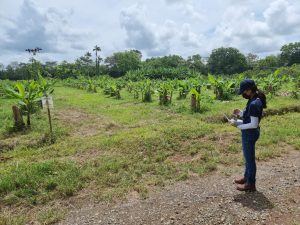 “To conduct the research, I have seven treatments, each simulating a different plan where I combine multiple products and cycles to see how Mancozeb could be most effectively decreased. I made all the applications with the AGRAS T-16 drone, and I was the pilot in charge of each application,” explains Alejandra.
“To conduct the research, I have seven treatments, each simulating a different plan where I combine multiple products and cycles to see how Mancozeb could be most effectively decreased. I made all the applications with the AGRAS T-16 drone, and I was the pilot in charge of each application,” explains Alejandra.
With the results, Alejandra determined that at the level of disease retention, using biorational products combined with cycles of systemic fungicide provided better protection of new leaves. In specific periods of her evaluation, she also found they maintain burn lesions on older leaves statistically similar and superior to Mancozeb. In the future, she plans to continue working with new technologies to improve the agricultural practices of banana growers worldwide.
Rabbit production in the tropics
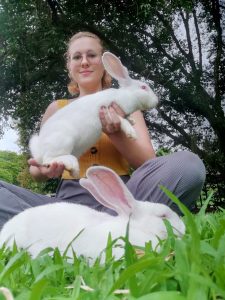 Nikita Fonseca (‘22, Costa Rica) wanted to do a Graduation Project in Animal Production to generate food systems solutions for her country and the world. While researching various options, she found that rabbit farming was a viable alternative. There are great nutritional benefits to this important protein source – the meat is lean and is rich in vitamin B12. And rabbit farming is a more sustainable and environmentally friendly solution than other types of meat production.
Nikita Fonseca (‘22, Costa Rica) wanted to do a Graduation Project in Animal Production to generate food systems solutions for her country and the world. While researching various options, she found that rabbit farming was a viable alternative. There are great nutritional benefits to this important protein source – the meat is lean and is rich in vitamin B12. And rabbit farming is a more sustainable and environmentally friendly solution than other types of meat production.
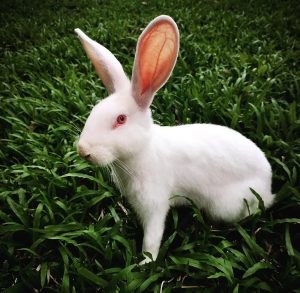 Initially, Nikita’s GP faced a challenge that caused some uncertainty: the hot and steamy climate in the Caribbean lowlands at the Guacimo Campus. Her research analyzes the relationship between heat, animal development, and weight. Rabbits develop better in temperatures between 18 and 22 degrees Celsius (64 – 72 F). They can get mild heat stress when temperatures increase to between 25 and 27 degrees Celsius (77 – 81 F). And at 27 to 30 degrees Celsius (81 – 86 F), rabbits endure high stress and even death due to heat shock. Nikita had to partially shave the animals’ fur in the most exposed areas to decrease their thermal sensation to ensure greater weight and food conversion. Thanks to her actions, she reduced the rabbits’ heat stress and increased reproduction and their weight.
Initially, Nikita’s GP faced a challenge that caused some uncertainty: the hot and steamy climate in the Caribbean lowlands at the Guacimo Campus. Her research analyzes the relationship between heat, animal development, and weight. Rabbits develop better in temperatures between 18 and 22 degrees Celsius (64 – 72 F). They can get mild heat stress when temperatures increase to between 25 and 27 degrees Celsius (77 – 81 F). And at 27 to 30 degrees Celsius (81 – 86 F), rabbits endure high stress and even death due to heat shock. Nikita had to partially shave the animals’ fur in the most exposed areas to decrease their thermal sensation to ensure greater weight and food conversion. Thanks to her actions, she reduced the rabbits’ heat stress and increased reproduction and their weight.
Nikita thinks this project can be an alternative for families looking to raise animals for their own consumption or start a family business. Rabbits can live in small spaces, feed on tree marigolds (botón de oro in Spanish) and mulberry, and reproduce extremely fast compared to other species used for human consumption.
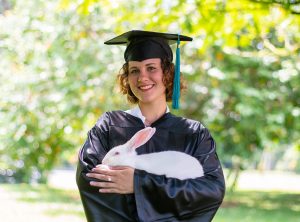 With great dedication, Nikita devoted herself to the care, disinfection, and temperature control for the well-being of the animals. She paid meticulous attention to the rabbits’ reproduction, lactation, and weaning. In addition, she is conducting a market study and has created alliances with people, institutions, and external companies. After graduation, she plans to dedicate herself to this project and turn it into an efficient business that integrates small producers.
With great dedication, Nikita devoted herself to the care, disinfection, and temperature control for the well-being of the animals. She paid meticulous attention to the rabbits’ reproduction, lactation, and weaning. In addition, she is conducting a market study and has created alliances with people, institutions, and external companies. After graduation, she plans to dedicate herself to this project and turn it into an efficient business that integrates small producers.
We congratulate Alejandra and Nikita for their commitment and dedication to their Graduation Projects – research with tangible results that can positively impact the world.




